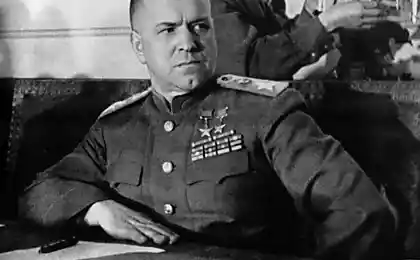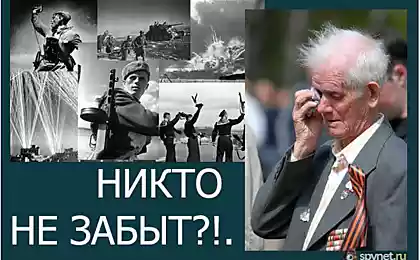1925
Four months Khalkhin - Gola
One of the undeclared wars in which the Soviet Union fought was the Khalkhin Gol (May 11 – September 16, 1939). It was in this war that the star of Marshal Zhukov rose, and he became a hero of the Mongolian Republic. Fighting took place on the territory of Mongolia near the border with the puppet state of Manchukuo (created by the Japanese Empire) near the Khalkhin Gol River.

Red Army tank attack. Khalkhin-Gol, August 1939. Beginning of conflict
Since January 1939, on the border of Mongolia, the Japanese have staged provocations, shelled the border guards of the Mongolian People’s Republic (MPR), attacked their outfits.
On the night of May 8, a Japanese detachment tried to capture an island on the Khalkin Gol River, the Mongolian border guards repulsed the attack. On May 11, a detachment of Japanese cavalry wedged 15 km deep into the territory of the MPR and attacked the border outpost, after the approach of reinforcements, the Mongols pushed the enemy to the border. The 14th Japanese detachment, supported by aviation, attacked the 7th border outpost of Mongolia, the Japanese occupied the height of Dungur-Obo, the 15th to the occupied height the Japanese moved 2 companies and 8 armored vehicles.
The Soviet Union was associated with the MPR “Protocol on mutual assistance”, our army reacted immediately: on the morning of May 17, units of the 57th Special Rifle Corps of N. V. Feklenko were sent to the conflict area, the 22nd Soviet units threw the enemy to the border. On May 22-28, the parties concentrated their forces in the area of the conflict: there were about 1,000 people from the USSR and the MPR, the Japanese concentrated more than 1,600 people. On May 28, the Japanese attacked in order to encircle the Soviet-Mongolian forces and cut them off from the crossing to the west bank of the river. Our forces retreated, the encirclement plan was thwarted. On the 29th our forces counterattacked and restored the situation.
Moscow said it would defend Mongolia’s borders “as its own” and began redeploying armored and airborne units. Thus, on May 1, there were 84 aircraft, on May 23 - 147, on June 17 - 267 aircraft.
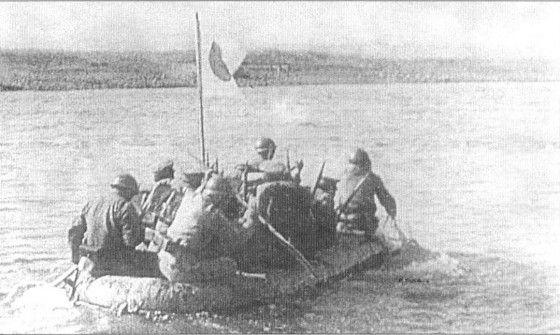
Japanese infantry are crossing the Khalkhin Gol River.
Air war
There were no land battles in June, but there was a fierce battle for air superiority. The first aircraft, the R-5 type, was lost on May 22. The first clashes of the USSR Air Force with the Japanese caused concern in Moscow: on May 27, the 1st Squadron 22 of the IAP (fighter aviation regiment) was defeated, the fighter of Major T.F. Kutsevalov did not take off due to engine malfunction, 4 more fighters left the battle and sat down for the same reason, of the four remaining pilots - two died. One was injured.
On May 28, the 4th Squadron 22 of the IAP was almost completely destroyed: out of 10 pilots, 5 were killed or missing, three were wounded. In early June, pilots with combat experience in Spain and China began arriving as instructors and organizers. It can be noted that pilots who did not have experience in combat, rather quickly adopted their experience, which indicates their overall good training. A group of pilots and technical specialists of 48 people led by the deputy head of the Red Army Air Force Ya.V. Smushkevich, besides him, 16 more pilots had the title of Hero of the Soviet Union, they were distributed in parts and began training personnel.
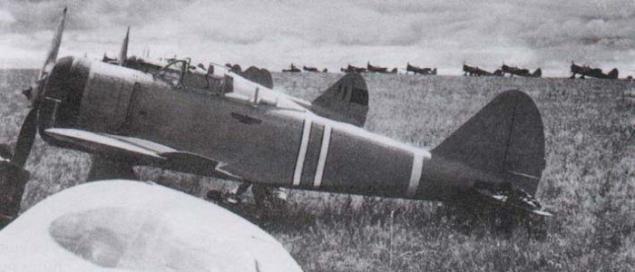
Japanese fighter Ki 27.

I-153 Coma Third Squadron 56 IAP Major Cherkasov. Reconstruction of Vladimir Zagorodnev.
At the beginning of the war in Manchuria and Korea, the Japanese Air Force had 274 aircraft, that is, they had no numerical superiority. In June, the Japanese in the conflict area had 77 fighters, 24 twin-engine bombers, 28 single-engine aircraft (scouts, light bombers).
Another reason for the large losses of the Soviet Air Force (in total during this war, the USSR lost 207, and Japan - 162-164 aircraft), was the mass use of biplane fighters. So, already on June 22, 13 of the 49 participating I-15 fighters (27%) and only one of the 13 I-16 fighters were lost in battle with the Japanese. The commander of the 4th Squadron 22 IAP pilot Evgeny Stepanov (passed the “school” of Spain) with difficulty left the battle and landed the I-15 with an interrupted thrust of engine control. Biplanes performed well in Spain and in 1939 became the most mass-produced fighter of the USSR, although alarming information was already coming from China. There our pilots encountered high-speed Japanese monoplanes.
On June 22-28 there were fierce air battles, on the 27th morning the Japanese Air Force managed to strike a sudden blow at Soviet airfields, they lost 5 aircraft, we 19. During these days, the Japanese Air Force lost about 90 aircraft, 38 of them.
The main and most modern monoplane of the Soviet Air Force in these battles was the I-16 monoplane, in many ways it allowed to turn the situation in favor of the Red Army Air Force.
Strategic planning for the aviation industry and the air force was also successful: Soviet military doctrine assumed the readiness to fight two wars simultaneously in the west and the east. The Soviet aviation industry not only created two groups of aviation, but also was able to make up for losses in a timely manner. This allowed the Air Force to support our troops in 1938 during the conflict on Hasan and at the same time in the Western strategic direction to keep 2,000 aircraft ready to support Czechoslovakia. In 1939, in the East, the Air Force fought at Khalkin Gol and at the same time supported the operation to annex Western Belarus and Western Ukraine.
The USSR created a quantitative advantage at the front with Japan, in the first half of August a new replenishment arrived - about 200 aircraft. By mid-August, along with the Mongolian P-5s, the Soviet Air Force had up to 558 combat aircraft, twice as many as the Japanese. Of these, 181 are SB bombers, which became the main striking force of the Air Force during the breakthrough of the Japanese front line during the offensive on August 20. Japan, due to its weak industrial base and simultaneous war in China (which absorbed most of the air force), was unable to increase its forces. Only at the end of the conflict, in September, were able to deploy 60 obsolete biplane fighters, bringing their forces to 295 aircraft. In addition, the Japanese did not have a significant number of trained pilots, their losses were irreparable.
In the first half of September, 7 air battles took place, the largest on September 15, 1939 (the day before the armistice) - 120 Japanese aircraft against 207 Soviet ones.
The air battles on Khalkin Gol are unique in that significant forces of the parties collided in a small space. They showed the importance of a good state of matchmaking, the need for rapid replenishment of pilots and equipment.
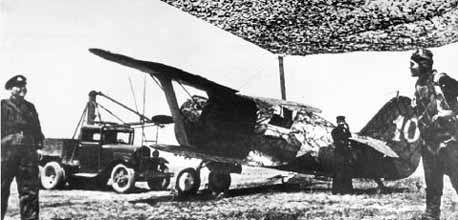
Khalkin-Gol, summer 1939. Preparation of the I-15 fighter for combat flight.
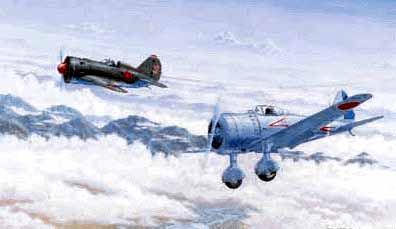
Halkin-Gol. The red star against the rising sun. E-16 v. Nakajima Ki.27.

Kutsevalov Timofey Fedorovich (1904-1975), Hero of the Soviet Union.
Land fighting
Zhukov was sent to Khalkin-Gol as an inspector, there is an opinion that contributed to his sending Budyonny, the old marshal respected Zhukov as a tough and demanding division commander. On May 30, Zhukov sent a critical report to Moscow, in which he reported that the Komkore was “smallly organized and not purposeful enough.” In early June, N.V. Feklenko was recalled to Moscow, and Zhukov was appointed in his place, the chief of his staff was the commander M.A. Bogdanov. This was an example of Stalin’s personnel principle: if you criticize, show yourself what you can do, Zhukov got a chance to stand out.
Soon the new headquarters proposed a plan: active defense on the bridgehead beyond Khalkhin Gol and preparation of a counterattack on the Japanese group. The god of war gave Zhukov time to prepare, air battles were going on all June, there were no major clashes on land.
The Japanese also did not sit idly by and at the end of the month prepared their operation, its purpose was to surround and destroy the Red Army forces on the east bank of the river, cross the river and break through the Soviet front. On July 2, the Japanese attacked, crossed the river and captured Bayan Tsagan Mountain, 40 km from the border. Japanese forces, while developing success, hastily strengthened the bridgehead. Zhukov, acting at his own risk to save the situation, was forced to ask for a mobile reserve - the 11th Tank Brigade of Commander M.P. Yakovlev with the Mongolian armored division, without the support of the rifle regiment. The brigade completed the task, the Japanese were defeated, though at the cost of losing more than half of the armored vehicles, but the situation was saved. Other units approached, the Japanese began to withdraw to stop them, the Japanese command blew up the only pontoon bridge, but on the morning of the 5th it was already a flight. The Japanese lost only killed several thousand people, almost all armored vehicles and artillery.

Mikhail Pavlovich Yakovlev (18 November 1903 – 12 July 1939), Hero of the Soviet Union posthumously.

Broken Soviet armored car BA-10.
On the east bank, Soviet forces retreated to the river, reducing their bridgehead, but were not defeated. In order to finally eliminate the threat of the MPR, it was necessary to defeat the Japanese on the eastern bank, restore the border. Zhukov began planning an offensive operation. The Japanese also planned an offensive operation, but given the sad experience, without crossing the river. They decided to limit themselves to the destruction of the Soviet bridgehead.
Additional forces were drawn up: the 82nd Infantry Division, the 37th Tank Brigade, in the Trans-Baikal Military District conducted a partial mobilization and two new divisions were formed. A consolidated battalion of border guards was transferred from the Trans-Baikal district to strengthen the border of the MPR, they detained dozens of Japanese intelligence officers. The 57th Corps was reorganized into the 1st Army (Front) Group.
The number of Soviet forces increased to 57 thousand fighters, the army group had 542 guns and mortars, about 500 tanks, 385 armored vehicles and 515 combat aircraft. The Japanese, in a specially created 6th army, had more than 75 thousand people, 500 guns, 182 tanks.
On July 8-11, fighting took place on the east bank of the river, and Soviet positions were held. On July 13-22, there was a lull, the Soviet side strengthened the bridgehead, the 24th Motorized Rifle Regiment of I. I. Fedyuninsky and the 5th Infantry and Submachine Gun Brigade were transferred to it. On July 23-24, the Japanese attacked, but they could not dislodge our forces from the bridgehead.

M. A. Bogdanov.
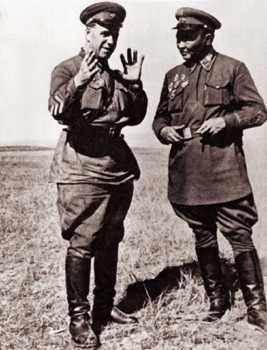
Komkor Zhukov and Marshal Choibalsan.
Defeat of the enemy
Soviet training took place in the strictest secrecy, all movements took place only at night, radio talks were conducted about the preparation of defense and plans for the autumn-winter campaign, at night sound systems broadcast the sounds of the movement of tanks and aircraft, so that the Japanese were accustomed to night traffic, and other measures were held to mislead the enemy.
As a result, the offensive, launched on August 20, was unexpected for the Japanese army, the Japanese planned to strike on August 24. This was a classic operation with flank strikes of mechanized and tank units, with the aim of encircling and defeating the enemy in the area between the river Khalkin-Gol and the state border of the MPR. The Red Army, under the command of Zhukov, carried out this experience before the famous Wehrmacht strikes in Poland, France, and the USSR. Three groups struck: the Southern group struck the main blow (Colonel M. I. Potapov), the Northern group struck an auxiliary blow (Colonel I. P. Alekseenko), the Central group shackled the enemy with battle (Combrig D. E. Petrov).
At 6.15 a.m., artillery training and airstrikes began, and at 9 a.m., ground forces launched an attack. The most brutal battles were in the Central direction, here the enemy had powerful fortifications. 21-22-th Zhukov entered the battle reserve - the 9th motorized armored brigade, the 23rd in the Central direction had to enter the last reserve - the 212th airborne brigade and two companies of border guards. Actively assisted the air force, only 24-25 August bombers made 218 sorties. The Japanese command was unable to determine the direction of the main attack and provide timely assistance to their flanks. By August 26, the encirclement was completed and significant forces of the 6th Japanese Army fell into the cauldron.
Japanese soldiers showed their best side, fought to the last, did not surrender, attempts to unblock the encircled forces were repulsed. By August 31, the territory of the MPR was cleared of the Japanese.
498950
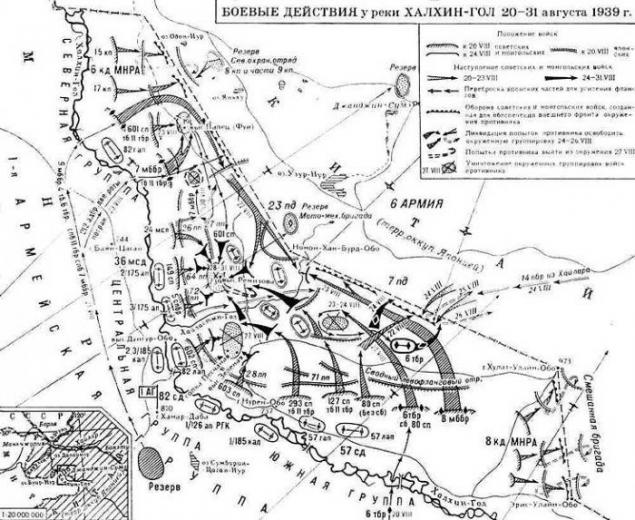
On September 4 and 8, Japanese forces attempted to occupy the Mongolian border areas, but were repulsed with heavy casualties (about 500 killed).
On September 15, 1939, an agreement was signed between the Soviet Union, Mongolia and Japan on the cessation of hostilities in the Khalkhin Gol River, which entered into force on September 16. The conflict was finally settled in May 1942, and a final agreement was signed to settle the problem: it was a compromise settlement based on old maps, largely in favor of Japan. The Soviet Union was in a difficult position and insisting on its own was diplomatically wrong. However, the agreement lasted only until 1945, then the MPR returned the plots ceded in 1942.
Outcome:
The demonstration of the military power of the USSR on Hasan and Khalkin-Gol showed Tokyo all the danger of war with the Red Army and became the main reason for the Japanese elite to choose the main direction of expansion - the South. And this, on the eve of the German attack on the USSR, was of great military and strategic importance, we received a relatively safe rear in the East.
Khalkin-Gol was the beginning of Zhukov’s magnificent career, before one of the numerous commanders became the commander of one of the most important military districts of the country – Kiev, and the chief of the General Staff.

Mititaro Komatsubara, who led the military operation of the Imperial Japanese Army near the Khalkhin Gol River, committed suicide in the autumn of 1940.

Zaisan Memorial, Ulaanbaatar.
Author Alexander Samson

Red Army tank attack. Khalkhin-Gol, August 1939. Beginning of conflict
Since January 1939, on the border of Mongolia, the Japanese have staged provocations, shelled the border guards of the Mongolian People’s Republic (MPR), attacked their outfits.
On the night of May 8, a Japanese detachment tried to capture an island on the Khalkin Gol River, the Mongolian border guards repulsed the attack. On May 11, a detachment of Japanese cavalry wedged 15 km deep into the territory of the MPR and attacked the border outpost, after the approach of reinforcements, the Mongols pushed the enemy to the border. The 14th Japanese detachment, supported by aviation, attacked the 7th border outpost of Mongolia, the Japanese occupied the height of Dungur-Obo, the 15th to the occupied height the Japanese moved 2 companies and 8 armored vehicles.
The Soviet Union was associated with the MPR “Protocol on mutual assistance”, our army reacted immediately: on the morning of May 17, units of the 57th Special Rifle Corps of N. V. Feklenko were sent to the conflict area, the 22nd Soviet units threw the enemy to the border. On May 22-28, the parties concentrated their forces in the area of the conflict: there were about 1,000 people from the USSR and the MPR, the Japanese concentrated more than 1,600 people. On May 28, the Japanese attacked in order to encircle the Soviet-Mongolian forces and cut them off from the crossing to the west bank of the river. Our forces retreated, the encirclement plan was thwarted. On the 29th our forces counterattacked and restored the situation.
Moscow said it would defend Mongolia’s borders “as its own” and began redeploying armored and airborne units. Thus, on May 1, there were 84 aircraft, on May 23 - 147, on June 17 - 267 aircraft.

Japanese infantry are crossing the Khalkhin Gol River.
Air war
There were no land battles in June, but there was a fierce battle for air superiority. The first aircraft, the R-5 type, was lost on May 22. The first clashes of the USSR Air Force with the Japanese caused concern in Moscow: on May 27, the 1st Squadron 22 of the IAP (fighter aviation regiment) was defeated, the fighter of Major T.F. Kutsevalov did not take off due to engine malfunction, 4 more fighters left the battle and sat down for the same reason, of the four remaining pilots - two died. One was injured.
On May 28, the 4th Squadron 22 of the IAP was almost completely destroyed: out of 10 pilots, 5 were killed or missing, three were wounded. In early June, pilots with combat experience in Spain and China began arriving as instructors and organizers. It can be noted that pilots who did not have experience in combat, rather quickly adopted their experience, which indicates their overall good training. A group of pilots and technical specialists of 48 people led by the deputy head of the Red Army Air Force Ya.V. Smushkevich, besides him, 16 more pilots had the title of Hero of the Soviet Union, they were distributed in parts and began training personnel.

Japanese fighter Ki 27.

I-153 Coma Third Squadron 56 IAP Major Cherkasov. Reconstruction of Vladimir Zagorodnev.
At the beginning of the war in Manchuria and Korea, the Japanese Air Force had 274 aircraft, that is, they had no numerical superiority. In June, the Japanese in the conflict area had 77 fighters, 24 twin-engine bombers, 28 single-engine aircraft (scouts, light bombers).
Another reason for the large losses of the Soviet Air Force (in total during this war, the USSR lost 207, and Japan - 162-164 aircraft), was the mass use of biplane fighters. So, already on June 22, 13 of the 49 participating I-15 fighters (27%) and only one of the 13 I-16 fighters were lost in battle with the Japanese. The commander of the 4th Squadron 22 IAP pilot Evgeny Stepanov (passed the “school” of Spain) with difficulty left the battle and landed the I-15 with an interrupted thrust of engine control. Biplanes performed well in Spain and in 1939 became the most mass-produced fighter of the USSR, although alarming information was already coming from China. There our pilots encountered high-speed Japanese monoplanes.
On June 22-28 there were fierce air battles, on the 27th morning the Japanese Air Force managed to strike a sudden blow at Soviet airfields, they lost 5 aircraft, we 19. During these days, the Japanese Air Force lost about 90 aircraft, 38 of them.
The main and most modern monoplane of the Soviet Air Force in these battles was the I-16 monoplane, in many ways it allowed to turn the situation in favor of the Red Army Air Force.
Strategic planning for the aviation industry and the air force was also successful: Soviet military doctrine assumed the readiness to fight two wars simultaneously in the west and the east. The Soviet aviation industry not only created two groups of aviation, but also was able to make up for losses in a timely manner. This allowed the Air Force to support our troops in 1938 during the conflict on Hasan and at the same time in the Western strategic direction to keep 2,000 aircraft ready to support Czechoslovakia. In 1939, in the East, the Air Force fought at Khalkin Gol and at the same time supported the operation to annex Western Belarus and Western Ukraine.
The USSR created a quantitative advantage at the front with Japan, in the first half of August a new replenishment arrived - about 200 aircraft. By mid-August, along with the Mongolian P-5s, the Soviet Air Force had up to 558 combat aircraft, twice as many as the Japanese. Of these, 181 are SB bombers, which became the main striking force of the Air Force during the breakthrough of the Japanese front line during the offensive on August 20. Japan, due to its weak industrial base and simultaneous war in China (which absorbed most of the air force), was unable to increase its forces. Only at the end of the conflict, in September, were able to deploy 60 obsolete biplane fighters, bringing their forces to 295 aircraft. In addition, the Japanese did not have a significant number of trained pilots, their losses were irreparable.
In the first half of September, 7 air battles took place, the largest on September 15, 1939 (the day before the armistice) - 120 Japanese aircraft against 207 Soviet ones.
The air battles on Khalkin Gol are unique in that significant forces of the parties collided in a small space. They showed the importance of a good state of matchmaking, the need for rapid replenishment of pilots and equipment.

Khalkin-Gol, summer 1939. Preparation of the I-15 fighter for combat flight.

Halkin-Gol. The red star against the rising sun. E-16 v. Nakajima Ki.27.

Kutsevalov Timofey Fedorovich (1904-1975), Hero of the Soviet Union.
Land fighting
Zhukov was sent to Khalkin-Gol as an inspector, there is an opinion that contributed to his sending Budyonny, the old marshal respected Zhukov as a tough and demanding division commander. On May 30, Zhukov sent a critical report to Moscow, in which he reported that the Komkore was “smallly organized and not purposeful enough.” In early June, N.V. Feklenko was recalled to Moscow, and Zhukov was appointed in his place, the chief of his staff was the commander M.A. Bogdanov. This was an example of Stalin’s personnel principle: if you criticize, show yourself what you can do, Zhukov got a chance to stand out.
Soon the new headquarters proposed a plan: active defense on the bridgehead beyond Khalkhin Gol and preparation of a counterattack on the Japanese group. The god of war gave Zhukov time to prepare, air battles were going on all June, there were no major clashes on land.
The Japanese also did not sit idly by and at the end of the month prepared their operation, its purpose was to surround and destroy the Red Army forces on the east bank of the river, cross the river and break through the Soviet front. On July 2, the Japanese attacked, crossed the river and captured Bayan Tsagan Mountain, 40 km from the border. Japanese forces, while developing success, hastily strengthened the bridgehead. Zhukov, acting at his own risk to save the situation, was forced to ask for a mobile reserve - the 11th Tank Brigade of Commander M.P. Yakovlev with the Mongolian armored division, without the support of the rifle regiment. The brigade completed the task, the Japanese were defeated, though at the cost of losing more than half of the armored vehicles, but the situation was saved. Other units approached, the Japanese began to withdraw to stop them, the Japanese command blew up the only pontoon bridge, but on the morning of the 5th it was already a flight. The Japanese lost only killed several thousand people, almost all armored vehicles and artillery.

Mikhail Pavlovich Yakovlev (18 November 1903 – 12 July 1939), Hero of the Soviet Union posthumously.

Broken Soviet armored car BA-10.
On the east bank, Soviet forces retreated to the river, reducing their bridgehead, but were not defeated. In order to finally eliminate the threat of the MPR, it was necessary to defeat the Japanese on the eastern bank, restore the border. Zhukov began planning an offensive operation. The Japanese also planned an offensive operation, but given the sad experience, without crossing the river. They decided to limit themselves to the destruction of the Soviet bridgehead.
Additional forces were drawn up: the 82nd Infantry Division, the 37th Tank Brigade, in the Trans-Baikal Military District conducted a partial mobilization and two new divisions were formed. A consolidated battalion of border guards was transferred from the Trans-Baikal district to strengthen the border of the MPR, they detained dozens of Japanese intelligence officers. The 57th Corps was reorganized into the 1st Army (Front) Group.
The number of Soviet forces increased to 57 thousand fighters, the army group had 542 guns and mortars, about 500 tanks, 385 armored vehicles and 515 combat aircraft. The Japanese, in a specially created 6th army, had more than 75 thousand people, 500 guns, 182 tanks.
On July 8-11, fighting took place on the east bank of the river, and Soviet positions were held. On July 13-22, there was a lull, the Soviet side strengthened the bridgehead, the 24th Motorized Rifle Regiment of I. I. Fedyuninsky and the 5th Infantry and Submachine Gun Brigade were transferred to it. On July 23-24, the Japanese attacked, but they could not dislodge our forces from the bridgehead.

M. A. Bogdanov.

Komkor Zhukov and Marshal Choibalsan.
Defeat of the enemy
Soviet training took place in the strictest secrecy, all movements took place only at night, radio talks were conducted about the preparation of defense and plans for the autumn-winter campaign, at night sound systems broadcast the sounds of the movement of tanks and aircraft, so that the Japanese were accustomed to night traffic, and other measures were held to mislead the enemy.
As a result, the offensive, launched on August 20, was unexpected for the Japanese army, the Japanese planned to strike on August 24. This was a classic operation with flank strikes of mechanized and tank units, with the aim of encircling and defeating the enemy in the area between the river Khalkin-Gol and the state border of the MPR. The Red Army, under the command of Zhukov, carried out this experience before the famous Wehrmacht strikes in Poland, France, and the USSR. Three groups struck: the Southern group struck the main blow (Colonel M. I. Potapov), the Northern group struck an auxiliary blow (Colonel I. P. Alekseenko), the Central group shackled the enemy with battle (Combrig D. E. Petrov).
At 6.15 a.m., artillery training and airstrikes began, and at 9 a.m., ground forces launched an attack. The most brutal battles were in the Central direction, here the enemy had powerful fortifications. 21-22-th Zhukov entered the battle reserve - the 9th motorized armored brigade, the 23rd in the Central direction had to enter the last reserve - the 212th airborne brigade and two companies of border guards. Actively assisted the air force, only 24-25 August bombers made 218 sorties. The Japanese command was unable to determine the direction of the main attack and provide timely assistance to their flanks. By August 26, the encirclement was completed and significant forces of the 6th Japanese Army fell into the cauldron.
Japanese soldiers showed their best side, fought to the last, did not surrender, attempts to unblock the encircled forces were repulsed. By August 31, the territory of the MPR was cleared of the Japanese.
498950

On September 4 and 8, Japanese forces attempted to occupy the Mongolian border areas, but were repulsed with heavy casualties (about 500 killed).
On September 15, 1939, an agreement was signed between the Soviet Union, Mongolia and Japan on the cessation of hostilities in the Khalkhin Gol River, which entered into force on September 16. The conflict was finally settled in May 1942, and a final agreement was signed to settle the problem: it was a compromise settlement based on old maps, largely in favor of Japan. The Soviet Union was in a difficult position and insisting on its own was diplomatically wrong. However, the agreement lasted only until 1945, then the MPR returned the plots ceded in 1942.
Outcome:
The demonstration of the military power of the USSR on Hasan and Khalkin-Gol showed Tokyo all the danger of war with the Red Army and became the main reason for the Japanese elite to choose the main direction of expansion - the South. And this, on the eve of the German attack on the USSR, was of great military and strategic importance, we received a relatively safe rear in the East.
Khalkin-Gol was the beginning of Zhukov’s magnificent career, before one of the numerous commanders became the commander of one of the most important military districts of the country – Kiev, and the chief of the General Staff.

Mititaro Komatsubara, who led the military operation of the Imperial Japanese Army near the Khalkhin Gol River, committed suicide in the autumn of 1940.

Zaisan Memorial, Ulaanbaatar.
Author Alexander Samson

